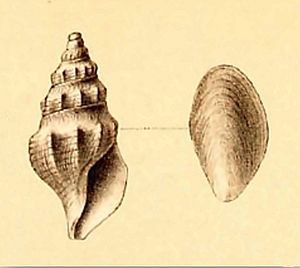Aoteadrillia bulbacea facts for kids
Quick facts for kids Aoteadrillia bulbacea |
|
|---|---|
 |
|
| Original image of a shell of Aoteadrillia bulbacea | |
| Scientific classification | |
| Synonyms | |
|
Aoteadrillia bulbacea is a type of sea snail. It's a marine mollusk that belongs to a group called gastropods. This specific snail is part of the family called Horaiclavidae.
It used to be placed in a different family, the Turridae family, but scientists have since reclassified it.
What Does Aoteadrillia bulbacea Look Like?
This sea snail has a shell that is generally wide and shaped like a cone. It has a distinct ridge, or "keel," around it. The bottom part of the shell is a bit narrow, and it has a short, pointed "snout."
The shell has small, narrow ridges running lengthwise. These ridges are separated by shallow grooves. Near the top of the shell, these ridges can have small bumps, like tiny tubercles. On the main part of the shell, there are usually about eleven of these ridges.
The shell also has spiral lines, like threads, that cross over the ridges. The very top of the shell, called the apex, looks a bit swollen or "bulbous."
The shell's surface is smooth and shiny, almost like porcelain, and it's usually a dull white color. Sometimes, it might have a pale brownish-yellow tint. The shell has about six and a half turns, or "whorls," that increase in size as they go down. The largest turn is the main body whorl.
The opening of the shell is shaped like a narrow oval. It has a special part called a siphonal canal at the front, which is like a short, open tube. The outer edge of the shell's opening, called the lip, curves inward slightly at the top, forming a shallow, V-shaped notch.
Inside the shell, there's a smooth, thin layer. The snail also has a small, oval-shaped "door" called an operculum. This operculum helps the snail close off its shell for protection.
Where Does Aoteadrillia bulbacea Live?
This marine snail is found only in the waters around the North Island of New Zealand. This means it is "endemic" to that area, living nowhere else in the world.

